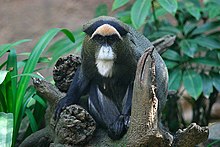List of mammals of the Central African Republic
This is a list of the mammal species recorded in the Central African Republic. There are 224 mammal species in the Central African Republic, of which four are endangered, eight are vulnerable, and nine are near threatened.[1]
The following tags are used to highlight each species' conservation status as assessed by the International Union for Conservation of Nature:
| EX | Extinct | No reasonable doubt that the last individual has died. |
| EW | Extinct in the wild | Known only to survive in captivity or as a naturalized populations well outside its previous range. |
| CR | Critically endangered | The species is in imminent risk of extinction in the wild. |
| EN | Endangered | The species is facing an extremely high risk of extinction in the wild. |
| VU | Vulnerable | The species is facing a high risk of extinction in the wild. |
| NT | Near threatened | The species does not meet any of the criteria that would categorise it as risking extinction but it is likely to do so in the future. |
| LC | Least concern | There are no current identifiable risks to the species. |
| DD | Data deficient | There is inadequate information to make an assessment of the risks to this species. |
Some species were assessed using an earlier set of criteria. Species assessed using this system have the following instead of near threatened and least concern categories:
| LR/cd | Lower risk/conservation dependent | Species which were the focus of conservation programmes and may have moved into a higher risk category if that programme was discontinued. |
| LR/nt | Lower risk/near threatened | Species which are close to being classified as vulnerable but are not the subject of conservation programmes. |
| LR/lc | Lower risk/least concern | Species for which there are no identifiable risks. |
Order: Afrosoricida (tenrecs and golden moles)[]
The order Afrosoricida contains the golden moles of southern Africa and the tenrecs of Madagascar and Africa, two families of small mammals that were traditionally part of the order Insectivora.
- Family: Tenrecidae (tenrecs)
- Subfamily: Potamogalinae
- Genus: Potamogale
- Giant otter shrew, Potamogale velox LC
- Genus: Potamogale
- Subfamily: Potamogalinae
- Family: Chrysochloridae
- Subfamily: Amblysominae
- Genus: Calcochloris
- Congo golden mole, Calcochloris leucorhinus DD
- Genus: Calcochloris
- Subfamily: Amblysominae
Order: Macroscelidea (elephant shrews)[]
Often called sengi, the elephant shrews or jumping shrews are native to southern Africa. Their common English name derives from their elongated flexible snout and their resemblance to the true shrews.
- Family: Macroscelididae (elephant shrews)
- Genus: Rhynchocyon
- Checkered elephant shrew, R. cirnei LC
- Genus: Rhynchocyon
Order: Hyracoidea (hyraxes)[]
The hyraxes are any of four species of fairly small, thickset, herbivorous mammals in the order Hyracoidea. About the size of a domestic cat they are well-furred, with rounded bodies and a stumpy tail. They are native to Africa and the Middle East.
- Family: Procaviidae (hyraxes)
- Genus: Dendrohyrax
- Western tree hyrax, Dendrohyrax dorsalis LC
- Genus: Dendrohyrax
Order: Proboscidea (elephants)[]
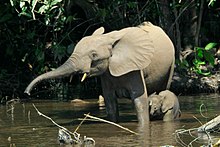
The elephants comprise three living species and are the largest living terrestrial animals.
- Family: Elephantidae
Order: Primates[]
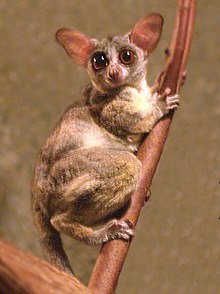

The order Primates contains humans and their closest relatives: lemurs, lorisoids, tarsiers, monkeys, and apes.
- Suborder: Strepsirrhini
- Infraorder: Lemuriformes
- Superfamily: Lorisoidea
- Family: Lorisidae (lorises, bushbabies)
- Genus: Arctocebus
- Golden angwantibo, Arctocebus aureus LR/nt
- Genus: Perodicticus
- Potto, Perodicticus potto LR/lc
- Genus: Arctocebus
- Family: Galagidae
- Genus: Sciurocheirus
- Bioko Allen's bushbaby, Sciurocheirus alleni LR/nt
- Genus: Galago
- Senegal bushbaby, Galago senegalensis LR/lc
- Genus: Galagoides
- Prince Demidoff's bushbaby, Galagoides demidovii LR/lc
- Genus: Euoticus
- Southern needle-clawed bushbaby, Euoticus elegantulus LR/nt
- Genus: Sciurocheirus
- Family: Lorisidae (lorises, bushbabies)
- Superfamily: Lorisoidea
- Infraorder: Lemuriformes
- Suborder: Haplorhini
- Infraorder: Simiiformes
- Parvorder: Catarrhini
- Superfamily: Cercopithecoidea
- Family: Cercopithecidae (Old World monkeys)
- Genus Allenopithecus
- Allen's swamp monkey, Allenopithecus nigroviridis[4]
- Genus: Erythrocebus
- Patas monkey, Erythrocebus patas LR/lc
- Genus: Chlorocebus
- Tantalus monkey, Chlorocebus tantalus LR/lc
- Genus: Cercopithecus
- Red-tailed monkey, Cercopithecus ascanius LR/lc
- Moustached guenon, Cercopithecus cephus LR/lc
- De Brazza's monkey, Cercopithecus neglectus LR/lc
- Greater spot-nosed monkey, Cercopithecus nictitans LR/lc
- Crowned guenon, Cercopithecus pogonias LR/lc
- Genus: Lophocebus
- Grey-cheeked mangabey, Lophocebus albigena LR/lc
- Genus: Papio
- Olive baboon, Papio anubis LR/lc
- Subfamily: Colobinae
- Genus: Colobus
- Mantled guereza, Colobus guereza LR/lc
- Genus: Procolobus
- Red colobus, Procolobus badius EN
- Genus: Colobus
- Genus Allenopithecus
- Family: Cercopithecidae (Old World monkeys)
- Superfamily: Hominoidea
- Family: Hominidae (great apes)
- Subfamily: Homininae
- Tribe: Gorillini
- Genus: Gorilla
- Western gorilla, Gorilla gorilla EN
- Genus: Gorilla
- Tribe: Panini
- Genus: Pan
- Common chimpanzee, Pan troglodytes EN
- Genus: Pan
- Tribe: Gorillini
- Subfamily: Homininae
- Family: Hominidae (great apes)
- Superfamily: Cercopithecoidea
- Parvorder: Catarrhini
- Infraorder: Simiiformes
Order: Rodentia (rodents)[]
Rodents make up the largest order of mammals, with over 40% of mammalian species. They have two incisors in the upper and lower jaw which grow continually and must be kept short by gnawing. Most rodents are small though the capybara can weigh up to 45 kg (99 lb).
- Suborder: Hystricognathi
- Family: Bathyergidae
- Genus: Cryptomys
- Ochre mole-rat, Cryptomys ochraceocinereus DD
- Genus: Cryptomys
- Family: Hystricidae (Old World porcupines)
- Genus: Hystrix
- Crested porcupine, Hystrix cristata LC
- Genus: Hystrix
- Family: Bathyergidae
- Suborder: Sciurognathi
- Family: Anomaluridae
- Subfamily: Anomalurinae
- Genus: Anomalurus
- Lord Derby's scaly-tailed squirrel, Anomalurus derbianus LC
- Dwarf scaly-tailed squirrel, Anomalurus pusillus LC
- Genus: Anomalurus
- Subfamily: Zenkerellinae
- Genus: Idiurus
- Flying mouse, Idiurus zenkeri DD
- Genus: Zenkerella
- Flightless scaly-tailed squirrel, Zenkerella insignis DD
- Genus: Idiurus
- Subfamily: Anomalurinae
- Family: Sciuridae (squirrels)
- Subfamily: Xerinae
- Tribe: Xerini
- Genus: Xerus
- Striped ground squirrel, Xerus erythropus LC
- Genus: Xerus
- Tribe: Protoxerini
- Genus: Funisciurus
- Thomas's rope squirrel, Funisciurus anerythrus DD
- Lady Burton's rope squirrel, Funisciurus isabella LC
- Red-cheeked rope squirrel, Funisciurus leucogenys DD
- Genus: Heliosciurus
- Gambian sun squirrel, Heliosciurus gambianus LC
- Red-legged sun squirrel, Heliosciurus rufobrachium LC
- Genus: Protoxerus
- Forest giant squirrel, Protoxerus stangeri LC
- Genus: Funisciurus
- Tribe: Xerini
- Subfamily: Xerinae
- Family: Gliridae (dormice)
- Subfamily: Graphiurinae
- Genus: Graphiurus
- Nagtglas's African dormouse, Graphiurus nagtglasii LC
- Kellen's dormouse, Graphiurus kelleni LC
- Genus: Graphiurus
- Subfamily: Graphiurinae
- Family: Nesomyidae
- Subfamily: Dendromurinae
- Genus: Prionomys
- Dollman's tree mouse, Prionomys batesi DD
- Genus: Prionomys
- Subfamily: Cricetomyinae
- Genus: Cricetomys
- Emin's pouched rat, Cricetomys emini LC
- Gambian pouched rat, Cricetomys gambianus LC
- Genus: Cricetomys
- Subfamily: Dendromurinae
- Family: Muridae (mice, rats, voles, gerbils, hamsters, etc.)
- Subfamily: Deomyinae
- Genus: Deomys
- Link rat, Deomys ferrugineus LC
- Genus: Lophuromys
- Fire-bellied brush-furred rat, Lophuromys nudicaudus LC
- Rusty-bellied brush-furred rat, Lophuromys sikapusi LC
- Genus: Uranomys
- Rudd's mouse, Uranomys ruddi LC
- Genus: Deomys
- Subfamily: Gerbillinae
- Genus: Tatera
- Kemp's gerbil, Tatera kempi LC
- Fringe-tailed gerbil, Tatera robusta LC
- Genus: Taterillus
- Congo gerbil, Taterillus congicus LC
- Harrington's gerbil, Taterillus harringtoni LC
- Genus: Tatera
- Subfamily: Murinae
- Genus: Aethomys
- Hinde's rock rat, Aethomys hindei LC
- Genus: Arvicanthis
- African grass rat, Arvicanthis niloticus LC
- Guinean grass rat, Arvicanthis rufinus LC
- Genus: Grammomys
- Macmillan's thicket rat, Grammomys macmillani LC
- Shining thicket rat, Grammomys rutilans LC
- Genus: Heimyscus
- African smoky mouse, Heimyscus fumosus LC
- Genus: Hybomys
- Peters's striped mouse, Hybomys univittatus LC
- Genus: Hylomyscus
- Beaded wood mouse, Hylomyscus aeta LC
- Little wood mouse, Hylomyscus parvus LC
- Stella wood mouse, Hylomyscus stella LC
- Genus: Malacomys
- Big-eared swamp rat, Malacomys longipes LC
- Genus: Mastomys
- Guinea multimammate mouse, Mastomys erythroleucus LC
- Natal multimammate mouse, Mastomys natalensis LC
- Genus: Mus
- Gounda mouse, Mus goundae DD
- African pygmy mouse, Mus minutoides LC
- Oubangui mouse, Mus oubanguii DD
- Peters's mouse, Mus setulosus LC
- Genus: Mylomys
- African groove-toothed rat, Mylomys dybowskii LC
- Genus: Myomyscus
- Brockman's rock mouse, Myomyscus brockmani LC
- Genus: Oenomys
- Common rufous-nosed rat, Oenomys hypoxanthus LC
- Genus: Praomys
- Dalton's mouse, Praomys daltoni LC
- Jackson's soft-furred mouse, Praomys jacksoni LC
- Petter's soft-furred mouse, Praomys petteri LC
- Genus: Stochomys
- Target rat, Stochomys longicaudatus LC
- Genus: Zelotomys
- Hildegarde's broad-headed mouse, Zelotomys hildegardeae LC
- Genus: Aethomys
- Subfamily: Deomyinae
- Family: Anomaluridae
Order: Lagomorpha (lagomorphs)[]
The lagomorphs comprise two families, Leporidae (hares and rabbits), and Ochotonidae (pikas). Though they can resemble rodents, and were classified as a superfamily in that order until the early 20th century, they have since been considered a separate order. They differ from rodents in a number of physical characteristics, such as having four incisors in the upper jaw rather than two.
- Family: Leporidae (rabbits, hares)
- Genus: Poelagus
- Bunyoro rabbit, Poelagus marjorita LR/lc
- Genus: Lepus
- Cape hare, Lepus capensis LR/lc
- Genus: Poelagus
Order: Erinaceomorpha (hedgehogs and gymnures)[]
The order Erinaceomorpha contains a single family, Erinaceidae, which comprise the hedgehogs and gymnures. The hedgehogs are easily recognised by their spines while gymnures look more like large rats.
- Family: Erinaceidae (hedgehogs)
- Subfamily: Erinaceinae
- Genus: Atelerix
- Four-toed hedgehog, Atelerix albiventris LR/lc
- Genus: Atelerix
- Subfamily: Erinaceinae
Order: Soricomorpha (shrews, moles, and solenodons)[]
The "shrew-forms" are insectivorous mammals. The shrews and solenodons closely resemble mice while the moles are stout-bodied burrowers.
- Family: Soricidae (shrews)
- Subfamily: Crocidurinae
- Genus: Crocidura
- Hun shrew, Crocidura attila LC
- Long-footed shrew, Crocidura crenata LC
- Dent's shrew, Crocidura denti LC
- Long-tailed musk shrew, Crocidura dolichura LC
- Fox's shrew, Crocidura foxi LC
- Savanna shrew, Crocidura fulvastra LC
- Bicolored musk shrew, Crocidura fuscomurina LC
- Goliath shrew, Crocidura goliath LC
- Grasse's shrew, Crocidura grassei LC
- Hildegarde's shrew, Crocidura hildegardeae LC
- Butiaba naked-tailed shrew, Crocidura littoralis LC
- Ludia's shrew, Crocidura ludia LC
- African black shrew, Crocidura nigrofusca LC
- Small-footed shrew, Crocidura parvipes LC
- Roosevelt's shrew, Crocidura roosevelti LC
- Turbo shrew, Crocidura turba LC
- Voi shrew, Crocidura voi LC
- Yankari shrew, Crocidura yankariensis LC
- Genus: Paracrocidura
- Lesser large-headed shrew, Paracrocidura schoutedeni LC
- Genus: Suncus
- Least dwarf shrew, Suncus infinitesimus LC
- Remy's pygmy shrew, Suncus remyi LC
- Genus: Sylvisorex
- Johnston's forest shrew, Sylvisorex johnstoni LC
- Kongana shrew, Sylvisorex konganensis DD
- Climbing shrew, Sylvisorex megalura LC
- Greater forest shrew, Sylvisorex ollula LC
- Genus: Crocidura
- Subfamily: Myosoricinae
- Genus: Congosorex
- Lesser Congo shrew, Congosorex verheyeni LC
- Genus: Congosorex
- Subfamily: Crocidurinae
Order: Chiroptera (bats)[]
The bats' most distinguishing feature is that their forelimbs are developed as wings, making them the only mammals capable of flight. Bat species account for about 20% of all mammals.
- Family: Pteropodidae (flying foxes, Old World fruit bats)
- Subfamily: Pteropodinae
- Genus: Casinycteris
- Short-palated fruit bat, Casinycteris argynnis NT
- Genus: Eidolon
- Straw-coloured fruit bat, Eidolon helvum LC
- Genus: Epomophorus
- Gambian epauletted fruit bat, Epomophorus gambianus LC
- Genus: Epomops
- Franquet's epauletted fruit bat, Epomops franqueti LC
- Genus: Hypsignathus
- Hammer-headed bat, Hypsignathus monstrosus LC
- Genus: Lissonycteris
- Angolan rousette, Lissonycteris angolensis LC
- Genus: Micropteropus
- Peters's dwarf epauletted fruit bat, Micropteropus pusillus LC
- Genus: Myonycteris
- Little collared fruit bat, Myonycteris torquata LC
- Genus: Nanonycteris
- Veldkamp's dwarf epauletted fruit bat, Nanonycteris veldkampi LC
- Genus: Scotonycteris
- Zenker's fruit bat, Scotonycteris zenkeri NT
- Genus: Casinycteris
- Subfamily: Macroglossinae
- Genus: Megaloglossus
- Woermann's bat, Megaloglossus woermanni LC
- Genus: Megaloglossus
- Subfamily: Pteropodinae
- Family: Vespertilionidae
- Subfamily: Kerivoulinae
- Genus: Kerivoula
- Lesser woolly bat, Kerivoula lanosa LC
- Genus: Kerivoula
- Subfamily: Myotinae
- Genus: Myotis
- Rufous mouse-eared bat, Myotis bocagii LC
- Genus: Myotis
- Subfamily: Vespertilioninae
- Genus: Glauconycteris
- Beatrix's bat, Glauconycteris beatrix NT
- Allen's spotted bat, Glauconycteris humeralis DD
- Genus: Mimetillus
- Moloney's mimic bat, Mimetillus moloneyi LC
- Genus: Neoromicia
- Cape serotine, Neoromicia capensis LC
- Tiny serotine, Neoromicia guineensis LC
- Banana pipistrelle, Neoromicia nanus LC
- Rendall's serotine, Neoromicia rendalli LC
- Somali serotine, Neoromicia somalicus LC
- Genus: Nycticeinops
- Schlieffen's bat, Nycticeinops schlieffeni LC
- Genus: Pipistrellus
- Tiny pipistrelle, Pipistrellus nanulus LC
- Rüppell's pipistrelle, Pipistrellus rueppelli LC
- Rusty pipistrelle, Pipistrellus rusticus LC
- Genus: Scotoecus
- Dark-winged lesser house bat, Scotoecus hirundo DD
- Genus: Scotophilus
- African yellow bat, Scotophilus dinganii LC
- White-bellied yellow bat, Scotophilus leucogaster LC
- Greenish yellow bat, Scotophilus viridis LC
- Genus: Glauconycteris
- Subfamily: Miniopterinae
- Genus: Miniopterus
- Greater long-fingered bat, Miniopterus inflatus LC
- Genus: Miniopterus
- Subfamily: Kerivoulinae
- Family: Rhinopomatidae
- Genus: Rhinopoma
- Greater mouse-tailed bat, Rhinopoma microphyllum LC
- Genus: Rhinopoma
- Family: Molossidae
- Genus: Chaerephon
- Duke of Abruzzi's free-tailed bat, Chaerephon aloysiisabaudiae NT
- Gland-tailed free-tailed bat, Chaerephon bemmeleni LC
- Genus: Mops
- Sierra Leone free-tailed bat, Mops brachypterus LC
- Midas free-tailed bat, Mops midas LC
- Spurrell's free-tailed bat, Mops spurrelli LC
- Railer bat, Mops thersites LC
- Trevor's free-tailed bat, Mops trevori VU
- Genus: Myopterus
- Daubenton's free-tailed bat, Myopterus daubentonii NT
- Bini free-tailed bat, Myopterus whitleyi LC
- Genus: Otomops
- Large-eared free-tailed bat, Otomops martiensseni NT
- Genus: Chaerephon
- Family: Emballonuridae
- Family: Nycteridae
- Genus: Nycteris
- Large slit-faced bat, Nycteris grandis LC
- Hairy slit-faced bat, Nycteris hispida LC
- Large-eared slit-faced bat, Nycteris macrotis LC
- Ja slit-faced bat, Nycteris major VU
- Dwarf slit-faced bat, Nycteris nana LC
- Egyptian slit-faced bat, Nycteris thebaica LC
- Genus: Nycteris
- Family: Megadermatidae
- Genus: Lavia
- Yellow-winged bat, Lavia frons LC
- Genus: Lavia
- Family: Rhinolophidae
- Subfamily: Rhinolophinae
- Genus: Rhinolophus
- Rüppell's horseshoe bat, Rhinolophus fumigatus LC
- Lander's horseshoe bat, Rhinolophus landeri LC
- Genus: Rhinolophus
- Subfamily: Hipposiderinae
- Genus: Hipposideros
- Aba roundleaf bat, Hipposideros abae NT
- Benito roundleaf bat, Hipposideros beatus LC
- Cyclops roundleaf bat, Hipposideros cyclops LC
- Giant roundleaf bat, Hipposideros gigas LC
- Commerson's roundleaf bat, Hipposideros marungensis NT
- Noack's roundleaf bat, Hipposideros ruber LC
- Genus: Triaenops
- Persian trident bat, Triaenops persicus LC
- Genus: Hipposideros
- Subfamily: Rhinolophinae
Order: Pholidota (pangolins)[]
The order Pholidota comprises the eight species of pangolin. Pangolins are anteaters and have the powerful claws, elongated snout and long tongue seen in the other unrelated anteater species.
- Family: Manidae
- Genus: Manis
- Giant pangolin, Manis gigantea LR/lc
- Ground pangolin, Manis temminckii LR/nt
- Long-tailed pangolin, Manis tetradactyla LR/lc
- Tree pangolin, Manis tricuspis LR/lc
- Genus: Manis
Order: Carnivora (carnivorans)[]

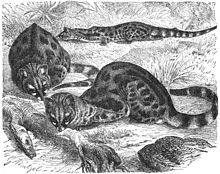

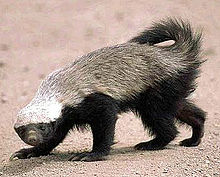
There are over 260 species of carnivorans, the majority of which feed primarily on meat. They have a characteristic skull shape and dentition.
- Suborder: Feliformia
- Family: Felidae (cats)
- Subfamily: Felinae
- Subfamily: Pantherinae
- Family: Viverridae
- Subfamily: Viverrinae
- Genus: Civettictis
- African civet, C. civetta LC[11]
- Genus: Genetta
- Genus: Poiana
- Central African oyan, P. richardsonii LC[15]
- Genus: Civettictis
- Subfamily: Viverrinae
- Family: Nandiniidae
- Genus: Nandinia
- African palm civet, N. binotata LC[16]
- Genus: Nandinia
- Family: Herpestidae (mongooses)
- Genus: Crossarchus
- Alexander's kusimanse, C. alexandri LC[17]
- Genus: Dologale
- Pousargues's mongoose, D. dybowskii DD[18]
- Genus: Herpestes
- Common slender mongoose, H. sanguineus LC
- Genus: Ichneumia
- White-tailed mongoose, I. albicauda LC[19]
- Genus: Mungos
- Banded mongoose, M. mungo LC
- Genus: Crossarchus
- Family: Hyaenidae (hyaenas)
- Family: Felidae (cats)
- Suborder: Caniformia
- Family: Canidae (dogs, foxes)
- Family: Mustelidae (mustelids)
Order: Artiodactyla (even-toed ungulates)[]





The even-toed ungulates are ungulates whose weight is borne about equally by the third and fourth toes, rather than mostly or entirely by the third as in perissodactyls. There are about 220 artiodactyl species, including many that are of great economic importance to humans.
- Family: Suidae (pigs)
- Subfamily: Phacochoerinae
- Genus: Phacochoerus
- Common warthog, Phacochoerus africanus LR/lc
- Genus: Phacochoerus
- Subfamily: Suinae
- Genus: Hylochoerus
- Giant forest hog, Hylochoerus meinertzhageni LR/lc
- Genus: Potamochoerus
- Red river hog, Potamochoerus porcus LR/lc
- Genus: Hylochoerus
- Subfamily: Phacochoerinae
- Family: Hippopotamidae (hippopotamuses)
- Genus: Hippopotamus
- Hippopotamus, H. amphibius VU[25]
- Genus: Hippopotamus
- Family: Tragulidae
- Genus: Hyemoschus
- Water chevrotain, Hyemoschus aquaticus DD
- Genus: Hyemoschus
- Family: Giraffidae (giraffe, okapi)
- Genus: Giraffa
- Kordofan giraffe, Giraffa camelopardalis antiquorum EN
- Genus: Giraffa
- Family: Bovidae (cattle, antelope, sheep, goats)
- Subfamily: Alcelaphinae
- Genus: Alcelaphus
- Hartebeest, Alcelaphus buselaphus LR/cd
- Genus: Damaliscus
- Topi, Damaliscus lunatus LR/cd
- Genus: Alcelaphus
- Subfamily: Antilopinae
- Genus: Gazella
- Red-fronted gazelle, Gazella rufifrons VU
- Genus: Neotragus
- Bates's pygmy antelope, Neotragus batesi LR/nt
- Genus: Oreotragus
- Klipspringer, Oreotragus oreotragus LR/cd
- Genus: Ourebia
- Oribi, Ourebia ourebi LR/cd
- Genus: Gazella
- Subfamily: Bovinae
- Genus: Syncerus
- African buffalo, Syncerus caffer LR/cd
- Genus: Tragelaphus
- Giant eland, Tragelaphus derbianus LR/nt
- Bongo, Tragelaphus eurycerus LR/nt
- Bushbuck, Tragelaphus scriptus LR/lc
- Sitatunga, Tragelaphus spekii LR/nt
- Greater kudu, Tragelaphus strepsiceros LR/cd
- Genus: Syncerus
- Subfamily: Cephalophinae
- Genus: Cephalophus
- Peters's duiker, Cephalophus callipygus LR/nt
- Bay duiker, Cephalophus dorsalis LR/nt
- White-bellied duiker, Cephalophus leucogaster LR/nt
- Blue duiker, Cephalophus monticola LR/lc
- Black-fronted duiker, Cephalophus nigrifrons LR/nt
- Red-flanked duiker, Cephalophus rufilatus LR/cd
- Yellow-backed duiker, Cephalophus silvicultor LR/nt
- Genus: Sylvicapra
- Common duiker, Sylvicapra grimmia LR/lc
- Genus: Cephalophus
- Subfamily: Hippotraginae
- Genus: Hippotragus
- Roan antelope, Hippotragus equinus LR/cd
- Genus: Hippotragus
- Subfamily: Reduncinae
- Genus: Kobus
- Waterbuck, Kobus ellipsiprymnus LR/cd
- Kob, Kobus kob LR/cd
- Genus: Redunca
- Bohor reedbuck, Redunca redunca LR/cd
- Genus: Kobus
- Subfamily: Alcelaphinae
See also[]
- List of chordate orders
- Lists of mammals by region
- List of prehistoric mammals
- Mammal classification
- List of mammals described in the 2000s
Notes[]
- ^ This list is derived from the IUCN Red List which lists species of mammals and includes those mammals that have recently been classified as extinct (since 1500 AD). The taxonomy and naming of the individual species is based on those used in existing Wikipedia articles as of 21 May 2007 and supplemented by the common names and taxonomy from the IUCN, Smithsonian Institution, or University of Michigan where no Wikipedia article was available.
- ^ Gobush, K.S.; Edwards, C.T.T.; Balfour, D.; Wittemyer, G.; Maisels, F.; Taylor, R.D. (2021). "Loxodonta africana". IUCN Red List of Threatened Species. 2021: e.T181008073A204401095. doi:10.2305/IUCN.UK.2021-2.RLTS.T181008073A204401095.en. Retrieved 18 November 2021.
- ^ Gobush, K.S.; Edwards, C.T.T.; Maisels, F.; Wittemyer, G.; Balfour, D.; Taylor, R.D. (2021). "Loxodonta cyclotis". IUCN Red List of Threatened Species. 2021: e.T181007989A204404464. doi:10.2305/IUCN.UK.2021-1.RLTS.T181007989A204404464.en. Retrieved 18 November 2021.
- ^ Cassidy, Rod. "Allens monkey Youtube". YouTube. Sangha Lodge. Archived from the original on 2021-12-21. Retrieved 21 September 2016.
- ^ Belbachir, F. (2008). "Acinonyx jubatus ssp. hecki". IUCN Red List of Threatened Species. 2008: e.T221A13035738.
- ^ Bahaa-el-din, L.; Mills, D.; Hunter, L. & Henschel, P. (2015). "Caracal aurata". IUCN Red List of Threatened Species. 2015: e.T18306A50663128.
- ^ Avgan, B.; Henschel, P. & Ghoddousi, A. (2016). "Caracal caracal". IUCN Red List of Threatened Species. 2016: e.T3847A102424310.
- ^ Thiel, C. (2015). "Leptailurus serval". IUCN Red List of Threatened Species. 2015: e.T11638A50654625.
- ^ Bauer, H.; Packer, C.; Funston, P. F.; Henschel, P. & Nowell, K. (2016). "Panthera leo". IUCN Red List of Threatened Species. 2016: e.T15951A115130419.
- ^ Stein, A.B.; Athreya, V.; Gerngross, P.; Balme, G.; Henschel, P.; Karanth, U.; Miquelle, D.; Rostro-Garcia, S.; Kamler, J. F.; Laguardia, A.; Khorozyan, I. & Ghoddousi, A. (2019). "Panthera pardus". IUCN Red List of Threatened Species. 2019: e.T15954A160698029.
- ^ Do Linh San, E.; Gaubert, P.; Wondmagegne, D. & Ray, J. (2015). "Civettictis civetta". IUCN Red List of Threatened Species. 2015: e.T41695A45218199.
- ^ Gaubert, P.; Carvalho, F.; Camps, D. & Do Linh San, E. (2015). "Genetta genetta". IUCN Red List of Threatened Species. 2015: e.T41698A45218636.
- ^ Angelici, F.M.; Gaubert, P. & Do Linh San, E. (2016). "Genetta maculata". IUCN Red List of Threatened Species. 2016: e.T41699A45218948.
- ^ Gaubert, P.; De Luca, D.W.; Rovero, F. & Do Linh San, E. (2016). "Genetta servalina". IUCN Red List of Threatened Species. 2016: e.T41700A97163789.
- ^ Gaubert, P. & Do Linh San, E. (2015). "Poiana richardsonii". IUCN Red List of Threatened Species. 2015: e.T41704A45219609.
- ^ Gaubert, P.; Bahaa-el-din, L.; Ray, J. & Do Linh San, E. (2015). "Nandinia binotata". IUCN Red List of Threatened Species. 2015: e.T41589A45204645.
- ^ Angelici, F. M. & Do Linh San, E. (2015). "Crossarchus alexandri". IUCN Red List of Threatened Species. 2015: e.T41593A45205341.
- ^ Aebischer, T.; Hickisch, R.; Woolgar, J. & Do Linh San, E. (2015). "Dologale dybowskii". IUCN Red List of Threatened Species. 2015: e.T41598A45205821.
- ^ Do Linh San, E. (2015). "Ichneumia albicauda". IUCN Red List of Threatened Species. 2015: e.T41620A45208640.
- ^ AbiSaid, M. & Dloniak, S.M.D. (2015). "Hyaena hyaena". IUCN Red List of Threatened Species. 2015: e.T10274A45195080.
- ^ Hoffmann, M. & Atickem, A. (2019). "Canis lupaster". IUCN Red List of Threatened Species. 2019: e.T118264888A118265889.
- ^ Woodroffe, R. & Sillero-Zubiri, C. (2020). "Lycaon pictus". IUCN Red List of Threatened Species. 2020: e.T12436A166502262.
- ^ Do Linh San, E.; Begg, C.; Begg, K. & Abramov, A. V. (2016). "Mellivora capensis". IUCN Red List of Threatened Species. 2016: e.T41629A45210107.
- ^ Reed-Smith, J.; Jacques, H. & Somers, M.J. (2015). "Hydrictis maculicollis". IUCN Red List of Threatened Species. 2015: e.T12420A21936042.
- ^ Lewison, R. & Pluháček, J. (2017). "Hippopotamus amphibius". IUCN Red List of Threatened Species. 2017: e.T10103A18567364.
References[]
- "The IUCN Red List of Threatened Species: Mammals of Central African Republic". IUCN. 2001. Retrieved 22 May 2007.[dead link]
- "Mammal Species of the World". Smithsonian National Museum of Natural History. 2005. Archived from the original on 27 April 2007. Retrieved 22 May 2007.
- "Animal Diversity Web". University of Michigan Museum of Zoology. 1995–2006. Retrieved 22 May 2007.
- Lists of mammals by location
- Lists of mammals of Africa
- Lists of biota of the Central African Republic
- Mammals of the Central African Republic
